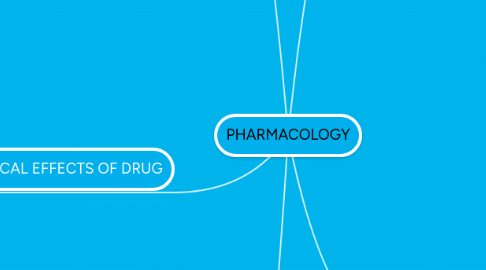
1. The drug or other substance has a potential for abuse less than the drugs or other substances in schedules I and II. The drug or other substance has a currently accepted medical use in treatment in the United States. Abuse of the drug or other substance may lead to moderate or low physical dependence or high psychological dependence
2. BIOLOGICAL EFFECTS OF DRUG
2.1. PREGNANCY CATEGORY
2.1.1. Category A: Controlled human studies have demonstrated no fetal risk.
2.1.2. Category B: Animal studies indicate no fetal risk, but no human studies; or adverse effects in animals, but not in well—controlled human studies.
2.1.3. Category C: No adequate human or animal studies; or adverse fetal effects in animal studies, but no available human data
2.1.4. Category D: Evidence of fetal risk, but benefits out-weigh risks
2.1.5. Category X: Evidence of fetal risk. Risks outweigh any benefits.
2.2. Controlled Substance Act
2.2.1. Schedule 1
2.2.1.1. No prescriptions may be written for Schedule I substances, and such substances are subject to production quotas by the DEA.
2.2.1.1.1. The drug or other substance has a high potential for abuse. The drug or other substance has no currently accepted medical use in treatment in the United States. There is a lack of accepted safety for use of the drug or other substance under medical supervision
2.2.2. Schedule 2
2.2.2.1. These drugs vary in potency: for example fentanyl is about 80 times as potent as morphine (heroin is roughly four times as potent). More significantly, they vary in nature. Pharmacology and CSA scheduling have a weak relationship
2.2.2.1.1. The drug or other substances have a high potential for abuse The drug or other substances have currently accepted medical use in treatment in the United States, or currently accepted medical use with severe restrictions Abuse of the drug or other substances may lead to severe psychological or physical dependence.
2.2.3. Schedule 3
2.2.3.1. The drug or other substances have a high potential for abuse
2.2.3.2. The drug or other substances have currently accepted medical use in treatment in the United States, or currently accepted medical use with severe restrictions
2.2.3.3. Abuse of the drug or other substances may lead to severe psychological or physical dependence.
2.2.4. Schedule 4
2.2.4.1. The drug or other substance has a potential for abuse less than the drugs or other substances in schedules I and II.
2.2.4.2. The drug or other substance has a currently accepted medical use in treatment in the United States.
2.2.4.3. Abuse of the drug or other substance may lead to moderate or low physical dependence or high psychological dependencet.
2.2.5. Schedule 5
2.2.5.1. No controlled substance in schedule V which is a drug may be distributed or dispensed other than for a medical purpose.[36] A prescription for controlled substances in Schedules III, IV, and V issued by a practitioner, may be communicated either orally, in writing, or by facsimile to the pharmacist, and may be refilled if so authorized on the prescription or by call-in
3. CHEMICAL SSUBSSTANCE FOUND IN DRUGS
3.1. Aluminum
3.1.1. Define actions as necessary
3.2. flouride
3.3. Gold
3.4. Iron
4. STUDY OF DRUGS
4.1. Pharmaceutics
4.1.1. Disintegration time
4.1.1.1. is the time required for a dosage form to break up in to granules of specified size (or smaller) under carefully specified conditions.
4.1.2. Dissolution
4.1.2.1. a process by which solid substance enters in the solvent to yield a solution. It is controlled by the affinity between the solid substance and the solvent.
4.2. Pharnacokinetics
4.2.1. Absorption
4.2.2. Distribution
4.2.3. Metabolism
4.2.4. Excretion
4.3. Pharmacodynamis
4.3.1. study of the biochemical and physiological effects of drugs on the body or on microorganisms or parasites within or on the body and the mechanisms of drug action and the relationship between drug concentration and effect.[1] One dominant example is drug-receptor interactions as modeled by
5. PHASES DRUG UNDERGOES
5.1. Preclinical
5.1.1. Testing of drug in non-human subjects, to gather efficacy, toxicity and pharmacokinetic information
5.1.2. not applicable in patients (in vitro and in vivo only)
5.1.3. Services
5.1.4. Duration
5.2. Phase I
5.2.1. Testing of drug on healthy volunteers for dose-ranging
5.2.2. determines whether drug is safe to check for efficacy
5.2.3. 20-10 people
5.3. Phase II
5.3.1. Testing of drug on patients to assess efficacy and safety
5.3.2. determines whether drug can have any efficacy; at this point, the drug is not presumed to have any therapeutic effect whatsoever
5.3.3. 100-300 people
5.4. Phase III
5.4.1. Testing of drug on patients to assess efficacy and safety
5.4.2. determines a drug's therapeutic effect; at this point, the drug is presumed to have some effect
5.4.3. therapeutic dose
5.4.4. 1000-2000
5.5. Phase IV:
5.5.1. Postmarketing surveillance – watching drug use in public
5.5.2. watch drug's long term effects
5.5.3. anyone seeking treatment from their physician
5.6. Phase V:
5.6.1. translational research
5.6.2. research on data collected
